软件开发过程中,不可避免的是需要处理各种异常,就我自己来说,至少有一半以上的时间都是在处理各种异常情况,所以代码中就会出现大量的 try {...} catch {...} finally {...}代码块,不仅有大量的冗余代码,而且还影响代码的可读性。
比较下面两张图,看看您现在编写的代码属于哪一种风格?然后哪种编码风格您更喜欢?丑陋的 try catch 代码块:
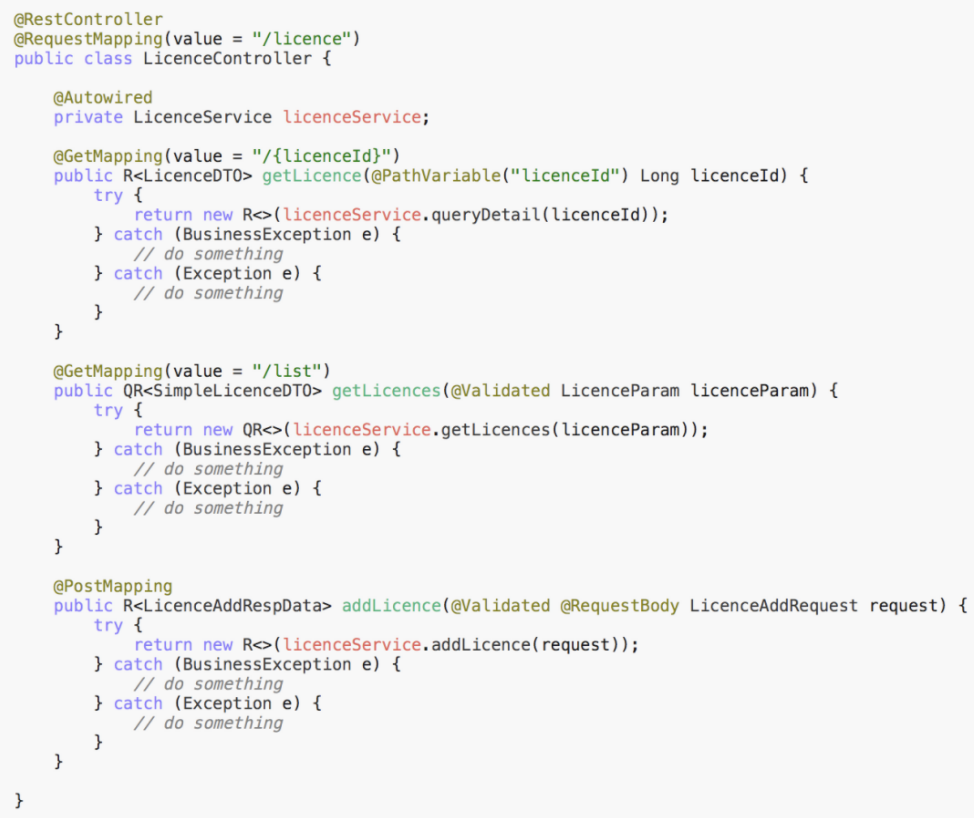 优雅的 Controller:
优雅的 Controller:
上面的示例,还只是在 Controller 层,如果是在 Service 层,可能会有更多的 try catch 代码块。这将会严重影响代码的可读性、“美观性”。
所以如果是我的话,我肯定偏向于第二种,我可以把更多的精力放在业务代码的开发,同时代码也会变得更加简洁。
既然业务代码不显式地对异常进行捕获、处理,而异常肯定还是处理的,不然系统岂不是动不动就崩溃了,所以必须得有其他地方捕获并处理这些异常。
那么问题来了,如何优雅的处理各种异常?
什么是统一异常处理
Spring 在 3.2 版本增加了一个注解 @ControllerAdvice,可以与 @ExceptionHandler、@InitBinder、@ModelAttribute 等注解注解配套使用。 对于这几个注解的作用,这里不做过多赘述,若有不了解的,可以参考 Spring 3.2 新注解 @ControllerAdvice,先大概有个了解。 不过跟异常处理相关的只有注解 @ExceptionHandler,从字面上看,就是异常处理器的意思。 其实际作用也是:若在某个 Controller 类定义一个异常处理方法,并在方法上添加该注解,那么当出现指定的异常时,会执行该处理异常的方法。 其可以使用 SpringMVC 提供的数据绑定,比如注入 HttpServletRequest 等,还可以接受一个当前抛出的 Throwable 对象。 但是,这样一来,就必须在每一个 Controller 类都定义一套这样的异常处理方法,因为异常可以是各种各样。这样一来,就会造成大量的冗余代码,而且若需要新增一种异常的处理逻辑,就必须修改所有 Controller 类了,很不优雅。 当然你可能会说,那就定义个类似 BaseController 的基类,这样总行了吧。 这种做法虽然没错,但仍不尽善尽美,因为这样的代码有一定的侵入性和耦合性。简简单单的 Controller,我为啥非得继承这样一个类呢,万一已经继承其他基类了呢。大家都知道 Java 只能继承一个类。 那有没有一种方案,既不需要跟 Controller 耦合,也可以将定义的异常处理器应用到所有控制器呢? 所以注解 @ControllerAdvice 出现了,简单的说,该注解可以把异常处理器应用到所有控制器,而不是单个控制器。 借助该注解,我们可以实现:在独立的某个地方,比如单独一个类,定义一套对各种异常的处理机制,然后在类的签名加上注解 @ControllerAdvice,统一对不同阶段的、不同异常进行处理。这就是统一异常处理的原理。注意到上面对异常按阶段进行分类,大体可以分成:进入 Controller 前的异常和 Service 层异常。
具体可以参考下图:
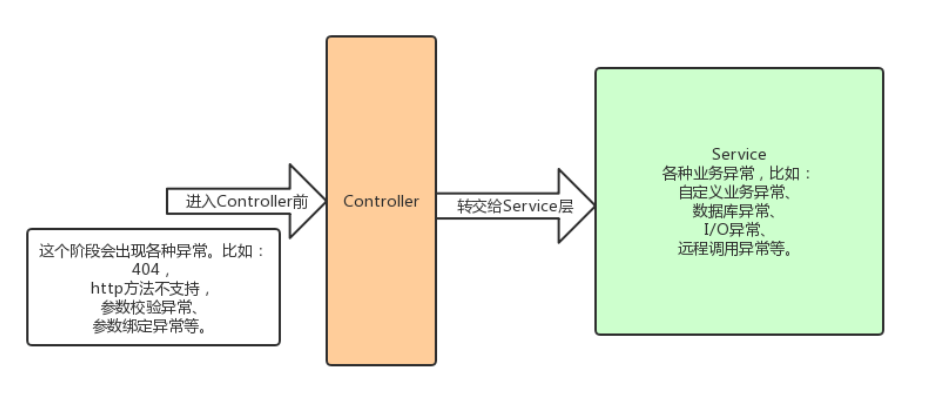
不同阶段的异常
目标
消灭 95% 以上的 try catch 代码块,以优雅的 Assert(断言)方式来校验业务的异常情况,只关注业务逻辑,而不用花费大量精力写冗余的 try catch 代码块。
统一异常处理实战
在定义统一异常处理类之前,先来介绍一下如何优雅的判定异常情况并抛异常。
| 用 Assert(断言)替换 throw exception
想必 Assert(断言)大家都很熟悉,比如 Spring 家族的org.springframework.util.Assert,在我们写测试用例的时候经常会用到。使用断言能让我们编码的时候有一种非一般丝滑的感觉,比如:
@Test
publicvoidtest1(){
...
Useruser=userDao.selectById(userId);
Assert.notNull(user,"用户不存在.");
...
}
@Test
publicvoidtest2(){
//另一种写法
Useruser=userDao.selectById(userId);
if(user==null){
thrownewIllegalArgumentException("用户不存在.");
}
}
有没有感觉第一种判定非空的写法很优雅,第二种写法则是相对丑陋的 if {...}代码块。那么神奇的 Assert.notNull()背后到底做了什么呢?
下面是 Assert 的部分源码:
publicabstractclassAssert{
publicAssert(){
}
publicstaticvoidnotNull(@NullableObjectobject,Stringmessage){
if(object==null){
thrownewIllegalArgumentException(message);
}
}
}
可以看到,Assert 其实就是帮我们把 if {...}封装了一下,是不是很神奇?虽然很简单,但不可否认的是编码体验至少提升了一个档次。
那么我们能不能模仿 org.springframework.util.Assert,也写一个断言类,不过断言失败后抛出的异常不是 IllegalArgumentException 这些内置异常,而是我们自己定义的异常。
下面让我们来尝试一下:
Assert
publicinterfaceAssert{
/**
*创建异常
*@paramargs
*@return
*/
BaseExceptionnewException(Object...args);
/**
*创建异常
*@paramt
*@paramargs
*@return
*/
BaseExceptionnewException(Throwablet,Object...args);
/**
*断言对象obj非空。如果对象obj为空,则抛出异常
*
*@paramobj待判断对象
*/
defaultvoidassertNotNull(Objectobj){
if(obj==null){
thrownewException(obj);
}
}
/**
*断言对象obj非空。如果对象obj为空,则抛出异常
*
异常信息message支持传递参数方式,避免在判断之前进行字符串拼接操作
*
*@paramobj待判断对象
*@paramargsmessage占位符对应的参数列表
*/
defaultvoidassertNotNull(Objectobj,Object...args){
if(obj==null){
thrownewException(args);
}
}
}
上面的 Assert 断言方法是使用接口的默认方法定义的,然后有没有发现当断言失败后,抛出的异常不是具体的某个异常,而是交由 2 个 newException 接口方法提供。
因为业务逻辑中出现的异常基本都是对应特定的场景,比如根据用户 id 获取用户信息,查询结果为 null,此时抛出的异常可能为 UserNotFoundException,并且有特定的异常码(比如 7001)和异常信息“用户不存在”。
所以具体抛出什么异常,由 Assert 的实现类决定。
看到这里,您可能会有这样的疑问,按照上面的说法,那岂不是有多少异常情况,就得有定义等量的断言类和异常类,这显然是反人类的,这也没想象中高明嘛。别急,且听我细细道来。
| 善解人意的 Enum
自定义异常 BaseException 有 2 个属性,即 code、message,这样一对属性,有没有想到什么类一般也会定义这 2个属性? 没错,就是枚举类。且看我如何将 Enum 和 Assert 结合起来,相信我一定会让你眼前一亮。如下:
publicinterfaceIResponseEnum{
intgetCode();
StringgetMessage();
}
/**
*业务异常
*业务处理时,出现异常,可以抛出该异常
*/
publicclassBusinessExceptionextendsBaseException{
privatestaticfinallongserialVersionUID=1L;
publicBusinessException(IResponseEnumresponseEnum,Object[]args,Stringmessage){
super(responseEnum,args,message);
}
publicBusinessException(IResponseEnumresponseEnum,Object[]args,Stringmessage,Throwablecause){
super(responseEnum,args,message,cause);
}
}
publicinterfaceBusinessExceptionAssertextendsIResponseEnum,Assert{
@Override
defaultBaseExceptionnewException(Object...args){
Stringmsg=MessageFormat.format(this.getMessage(),args);
returnnewBusinessException(this,args,msg);
}
@Override
defaultBaseExceptionnewException(Throwablet,Object...args){
Stringmsg=MessageFormat.format(this.getMessage(),args);
returnnewBusinessException(this,args,msg,t);
}
}
@Getter
@AllArgsConstructor
publicenumResponseEnumimplementsBusinessExceptionAssert{
/**
*Badlicencetype
*/
BAD_LICENCE_TYPE(7001,"Badlicencetype."),
/**
*Licencenotfound
*/
LICENCE_NOT_FOUND(7002,"Licencenotfound.")
;
/**
*返回码
*/
privateintcode;
/**
*返回消息
*/
privateStringmessage;
}
看到这里,有没有眼前一亮的感觉,代码示例中定义了两个枚举实例:-
BAD_LICENCE_TYPE
-
LICENCE_NOT_FOUND
以后每增加一种异常情况,只需增加一个枚举实例即可,再也不用每一种异常都定义一个异常类了。然后再来看下如何使用,假设 LicenceService 有校验 Licence 是否存在的方法,如下:
/**
*校验{@linkLicence}存在
*@paramlicence
*/
privatevoidcheckNotNull(Licencelicence){
ResponseEnum.LICENCE_NOT_FOUND.assertNotNull(licence);
}
若不使用断言,代码可能如下:
privatevoidcheckNotNull(Licencelicence){
if(licence==null){
thrownewLicenceNotFoundException();
//或者这样
thrownewBusinessException(7001,"Badlicencetype.");
}
}
使用枚举类结合(继承)Assert,只需根据特定的异常情况定义不同的枚举实例,如上面的 BAD_LICENCE_TYPE、LICENCE_NOT_FOUND,就能够针对不同情况抛出特定的异常(这里指携带特定的异常码和异常消息)。
这样既不用定义大量的异常类,同时还具备了断言的良好可读性,当然这种方案的好处远不止这些,请继续阅读后文,慢慢体会。
注:上面举的例子是针对特定的业务,而有部分异常情况是通用的,比如:服务器繁忙、网络异常、服务器异常、参数校验异常、404 等,所以有CommonResponseEnum、ArgumentResponseEnum、ServletResponseEnum,其中 ServletResponseEnum 会在后文详细说明。
| 定义统一异常处理器类
@Slf4j
@Component
@ControllerAdvice
@ConditionalOnWebApplication
@ConditionalOnMissingBean(UnifiedExceptionHandler.class)
publicclassUnifiedExceptionHandler{
/**
*生产环境
*/
privatefinalstaticStringENV_PROD="prod";
@Autowired
privateUnifiedMessageSourceunifiedMessageSource;
/**
*当前环境
*/
@Value("${spring.profiles.active}")
privateStringprofile;
/**
*获取国际化消息
*
*@parame异常
*@return
*/
publicStringgetMessage(BaseExceptione){
Stringcode="response."+e.getResponseEnum().toString();
Stringmessage=unifiedMessageSource.getMessage(code,e.getArgs());
if(message==null||message.isEmpty()){
returne.getMessage();
}
returnmessage;
}
/**
*业务异常
*
*@parame异常
*@return异常结果
*/
@ExceptionHandler(value=BusinessException.class)
@ResponseBody
publicErrorResponsehandleBusinessException(BaseExceptione){
log.error(e.getMessage(),e);
returnnewErrorResponse(e.getResponseEnum().getCode(),getMessage(e));
}
/**
*自定义异常
*
*@parame异常
*@return异常结果
*/
@ExceptionHandler(value=BaseException.class)
@ResponseBody
publicErrorResponsehandleBaseException(BaseExceptione){
log.error(e.getMessage(),e);
returnnewErrorResponse(e.getResponseEnum().getCode(),getMessage(e));
}
/**
*Controller上一层相关异常
*
*@parame异常
*@return异常结果
*/
@ExceptionHandler({
NoHandlerFoundException.class,
HttpRequestMethodNotSupportedException.class,
HttpMediaTypeNotSupportedException.class,
MissingPathVariableException.class,
MissingServletRequestParameterException.class,
TypeMismatchException.class,
HttpMessageNotReadableException.class,
HttpMessageNotWritableException.class,
//BindException.class,
//MethodArgumentNotValidException.class
HttpMediaTypeNotAcceptableException.class,
ServletRequestBindingException.class,
ConversionNotSupportedException.class,
MissingServletRequestPartException.class,
AsyncRequestTimeoutException.class
})
@ResponseBody
publicErrorResponsehandleServletException(Exceptione){
log.error(e.getMessage(),e);
intcode=CommonResponseEnum.SERVER_ERROR.getCode();
try{
ServletResponseEnumservletExceptionEnum=ServletResponseEnum.valueOf(e.getClass().getSimpleName());
code=servletExceptionEnum.getCode();
}catch(IllegalArgumentExceptione1){
log.error("class[{}]notdefinedinenum{}",e.getClass().getName(),ServletResponseEnum.class.getName());
}
if(ENV_PROD.equals(profile)){
//当为生产环境,不适合把具体的异常信息展示给用户,比如404.
code=CommonResponseEnum.SERVER_ERROR.getCode();
BaseExceptionbaseException=newBaseException(CommonResponseEnum.SERVER_ERROR);
Stringmessage=getMessage(baseException);
returnnewErrorResponse(code,message);
}
returnnewErrorResponse(code,e.getMessage());
}
/**
*参数绑定异常
*
*@parame异常
*@return异常结果
*/
@ExceptionHandler(value=BindException.class)
@ResponseBody
publicErrorResponsehandleBindException(BindExceptione){
log.error("参数绑定校验异常",e);
returnwrapperBindingResult(e.getBindingResult());
}
/**
*参数校验异常,将校验失败的所有异常组合成一条错误信息
*
*@parame异常
*@return异常结果
*/
@ExceptionHandler(value=MethodArgumentNotValidException.class)
@ResponseBody
publicErrorResponsehandleValidException(MethodArgumentNotValidExceptione){
log.error("参数绑定校验异常",e);
returnwrapperBindingResult(e.getBindingResult());
}
/**
*包装绑定异常结果
*
*@parambindingResult绑定结果
*@return异常结果
*/
privateErrorResponsewrapperBindingResult(BindingResultbindingResult){
StringBuildermsg=newStringBuilder();
for(ObjectErrorerror:bindingResult.getAllErrors()){
msg.append(",");
if(errorinstanceofFieldError){
msg.append(((FieldError)error).getField()).append(":");
}
msg.append(error.getDefaultMessage()==null?"":error.getDefaultMessage());
}
returnnewErrorResponse(ArgumentResponseEnum.VALID_ERROR.getCode(),msg.substring(2));
}
/**
*未定义异常
*
*@parame异常
*@return异常结果
*/
@ExceptionHandler(value=Exception.class)
@ResponseBody
publicErrorResponsehandleException(Exceptione){
log.error(e.getMessage(),e);
if(ENV_PROD.equals(profile)){
//当为生产环境,不适合把具体的异常信息展示给用户,比如数据库异常信息.
intcode=CommonResponseEnum.SERVER_ERROR.getCode();
BaseExceptionbaseException=newBaseException(CommonResponseEnum.SERVER_ERROR);
Stringmessage=getMessage(baseException);
returnnewErrorResponse(code,message);
}
returnnewErrorResponse(CommonResponseEnum.SERVER_ERROR.getCode(),e.getMessage());
}
}
可以看到,上面将异常分成几类,实际上只有两大类,一类是 ServletException、ServiceException。
还记得上文提到的按阶段分类吗,即对应进入 Controller 前的异常 和 Service 层异常;然后 ServiceException 再分成自定义异常、未知异常。
对应关系如下:
-
进入 Controller 前的异常:handleServletException、handleBindException、handleValidException
-
自定义异常:handleBusinessException、handleBaseException
-
未知异常:handleException
异常处理器说明
| handleServletException
一个 http 请求,在到达 Controller 前,会对该请求的请求信息与目标控制器信息做一系列校验。
这里简单说一下:
NoHandlerFoundException:首先根据请求 Url 查找有没有对应的控制器,若没有则会抛该异常,也就是大家非常熟悉的 404 异常。
HttpRequestMethodNotSupportedException:若匹配到了(匹配结果是一个列表,不同的是 http 方法不同,如:Get、Post 等),则尝试将请求的 http 方法与列表的控制器做匹配,若没有对应 http 方法的控制器,则抛该异常。
HttpMediaTypeNotSupportedException:然后再对请求头与控制器支持的做比较。
比如 content-type 请求头,若控制器的参数签名包含注解 @RequestBody,但是请求的 content-type 请求头的值没有包含 application/json,那么会抛该异常(当然,不止这种情况会抛这个异常)。
MissingPathVariableException:未检测到路径参数。比如 url 为:/licence/{licenceId},参数签名包含 @PathVariable("licenceId")。
当请求的 url 为 /licence,在没有明确定义 url 为 /licence 的情况下,会被判定为:缺少路径参数。
MissingServletRequestParameterException:缺少请求参数。比如定义了参数 @RequestParam("licenceId") String licenceId,但发起请求时,未携带该参数,则会抛该异常。
TypeMismatchException:参数类型匹配失败。比如:接收参数为 Long 型,但传入的值确是一个字符串,那么将会出现类型转换失败的情况,这时会抛该异常。
HttpMessageNotReadableException:与上面的 HttpMediaTypeNotSupportedException 举的例子完全相反。
即请求头携带了"content-type: application/json;charset=UTF-8",但接收参数却没有添加注解 @RequestBody,或者请求体携带的 json 串反序列化成 pojo 的过程中失败了,也会抛该异常。
HttpMessageNotWritableException:返回的 pojo 在序列化成 json 过程失败了,那么抛该异常。
| handleBindException
参数校验异常,后文详细说明。| handleValidException
参数校验异常,后文详细说明。| handleBusinessException、handleBaseException
处理自定义的业务异常,只是 handleBaseException 处理的是除了 BusinessException 意外的所有业务异常。就目前来看,这 2 个是可以合并成一个的。
| handleException
处理所有未知的异常,比如操作数据库失败的异常。 注:上面的 handleServletException、handleException 这两个处理器,返回的异常信息,不同环境返回的可能不一样,以为这些异常信息都是框架自带的异常信息,一般都是英文的,不太好直接展示给用户看,所以统一返回 SERVER_ERROR 代表的异常信息。异于常人的404
上文提到,当请求没有匹配到控制器的情况下,会抛出 NoHandlerFoundException 异常,但其实默认情况下不是这样,默认情况下会出现类似如下页面: Whitelabel Error Page
这个页面是如何出现的呢?实际上,当出现 404 的时候,默认是不抛异常的,而是 forward 跳转到 /error 控制器。
Whitelabel Error Page
这个页面是如何出现的呢?实际上,当出现 404 的时候,默认是不抛异常的,而是 forward 跳转到 /error 控制器。
Spring 也提供了默认的 error 控制器,如下:
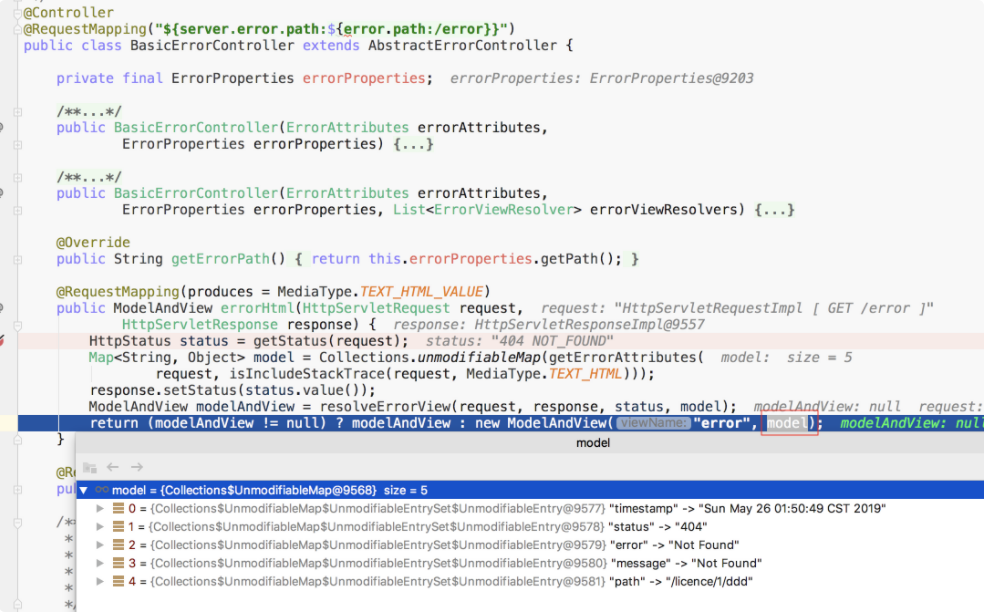 那么,如何让 404 也抛出异常呢,只需在 properties 文件中加入如下配置即可:
那么,如何让 404 也抛出异常呢,只需在 properties 文件中加入如下配置即可:
spring.mvc.throw-exception-if-no-handler-found=true
spring.resources.add-mappings=false
如此,就可以异常处理器中捕获它了,然后前端只要捕获到特定的状态码,立即跳转到 404 页面即可。
捕获404对应的异常
|统一返回结果
在验证统一异常处理器之前,顺便说一下统一返回结果。说白了,其实是统一一下返回结果的数据结构。
code、message 是所有返回结果中必有的字段,而当需要返回数据时,则需要另一个字段 data 来表示。
所以首先定义一个 BaseResponse 来作为所有返回结果的基类;然后定义一个通用返回结果类 CommonResponse,继承 BaseResponse,而且多了字段 data。
为了区分成功和失败返回结果,于是再定义一个 ErrorResponse。
最后还有一种常见的返回结果,即返回的数据带有分页信息,因为这种接口比较常见,所以有必要单独定义一个返回结果类 QueryDataResponse。
该类继承自 CommonResponse,只是把 data 字段的类型限制为 QueryDdata,QueryDdata中定义了分页信息相应的字段,即 totalCount、pageNo、 pageSize、records。
其中比较常用的只有 CommonResponse 和 QueryDataResponse,但是名字又贼鬼死长,何不定义 2 个名字超简单的类来替代呢?
于是 R 和 QR 诞生了,以后返回结果的时候只需这样写:new R<>(data)、new QR<>(queryData)。
所有的返回结果类的定义这里就不贴出来了。
| 验证统一异常处理
因为这一套统一异常处理可以说是通用的,所有可以设计成一个 common包,以后每一个新项目/模块只需引入该包即可。所以为了验证,需要新建一个项目,并引入该 common 包。
下面是用于验证的主要源码:
@Service
publicclassLicenceServiceextendsServiceImpl<LicenceMapper,Licence>{
@Autowired
privateOrganizationClientorganizationClient;
/**
*查询{@linkLicence}详情
*@paramlicenceId
*@return
*/
publicLicenceDTOqueryDetail(LonglicenceId){
Licencelicence=this.getById(licenceId);
checkNotNull(licence);
OrganizationDTOorg=ClientUtil.execute(()->organizationClient.getOrganization(licence.getOrganizationId()));
returntoLicenceDTO(licence,org);
}
/**
*分页获取
*@paramlicenceParam分页查询参数
*@return
*/
publicQueryDatagetLicences(LicenceParamlicenceParam) {
StringlicenceType=licenceParam.getLicenceType();
LicenceTypeEnumlicenceTypeEnum=LicenceTypeEnum.parseOfNullable(licenceType);
//断言,非空
ResponseEnum.BAD_LICENCE_TYPE.assertNotNull(licenceTypeEnum);
LambdaQueryWrapperwrapper=newLambdaQueryWrapper<>();
wrapper.eq(Licence::getLicenceType,licenceType);
IPagepage=this.page(newQueryPage<>(licenceParam),wrapper);
returnnewQueryData<>(page,this::toSimpleLicenceDTO);
}
/**
*新增{@linkLicence}
*@paramrequest请求体
*@return
*/
@Transactional(rollbackFor=Throwable.class)
publicLicenceAddRespDataaddLicence(LicenceAddRequestrequest){
Licencelicence=newLicence();
licence.setOrganizationId(request.getOrganizationId());
licence.setLicenceType(request.getLicenceType());
licence.setProductName(request.getProductName());
licence.setLicenceMax(request.getLicenceMax());
licence.setLicenceAllocated(request.getLicenceAllocated());
licence.setComment(request.getComment());
this.save(licence);
returnnewLicenceAddRespData(licence.getLicenceId());
}
/**
*entity->simpledto
*@paramlicence{@linkLicence}entity
*@return{@linkSimpleLicenceDTO}
*/
privateSimpleLicenceDTOtoSimpleLicenceDTO(Licencelicence){
//省略
}
/**
*entity->dto
*@paramlicence{@linkLicence}entity
*@paramorg{@linkOrganizationDTO}
*@return{@linkLicenceDTO}
*/
privateLicenceDTOtoLicenceDTO(Licencelicence,OrganizationDTOorg){
//省略
}
/**
*校验{@linkLicence}存在
*@paramlicence
*/
privatevoidcheckNotNull(Licencelicence){
ResponseEnum.LICENCE_NOT_FOUND.assertNotNull(licence);
}
}
PS:这里使用的 DAO 框架是 mybatis-plus。
启动时,自动插入的数据为:
--licence
INSERTINTOlicence(licence_id,organization_id,licence_type,product_name,licence_max,licence_allocated)
VALUES(1,1,'user','CustomerPro',100,5);
INSERTINTOlicence(licence_id,organization_id,licence_type,product_name,licence_max,licence_allocated)
VALUES(2,1,'user','suitability-plus',200,189);
INSERTINTOlicence(licence_id,organization_id,licence_type,product_name,licence_max,licence_allocated)
VALUES(3,2,'user','HR-PowerSuite',100,4);
INSERTINTOlicence(licence_id,organization_id,licence_type,product_name,licence_max,licence_allocated)
VALUES(4,2,'core-prod','WildCatApplicationGateway',16,16);
--organizations
INSERTINTOorganization(id,name,contact_name,contact_email,contact_phone)
VALUES(1,'customer-crm-co','MarkBalster','mark.balster@custcrmco.com','823-555-1212');
INSERTINTOorganization(id,name,contact_name,contact_email,contact_phone)
VALUES(2,'HR-PowerSuite','DougDrewry','doug.drewry@hr.com','920-555-1212');
开始验证
| 捕获自定义异常
①获取不存在的 licence 详情:http://localhost:10000/licence/5
成功响应的请求:
licenceId=1
检验非空:
 捕获 Licence not found 异常:
捕获 Licence not found 异常:
Licence not found:

②根据不存在的 licence type 获取 licence 列表:http://localhost:10000/licence/list?licenceType=ddd。可选的 licence type 为:user、core-prod 。
校验非空:

捕获 Bad licence type 异常:

Bad licence type:

| 捕获进入 Controller 前的异常
①访问不存在的接口:http://localhost:10000/licence/list/ddd
捕获 404 异常:
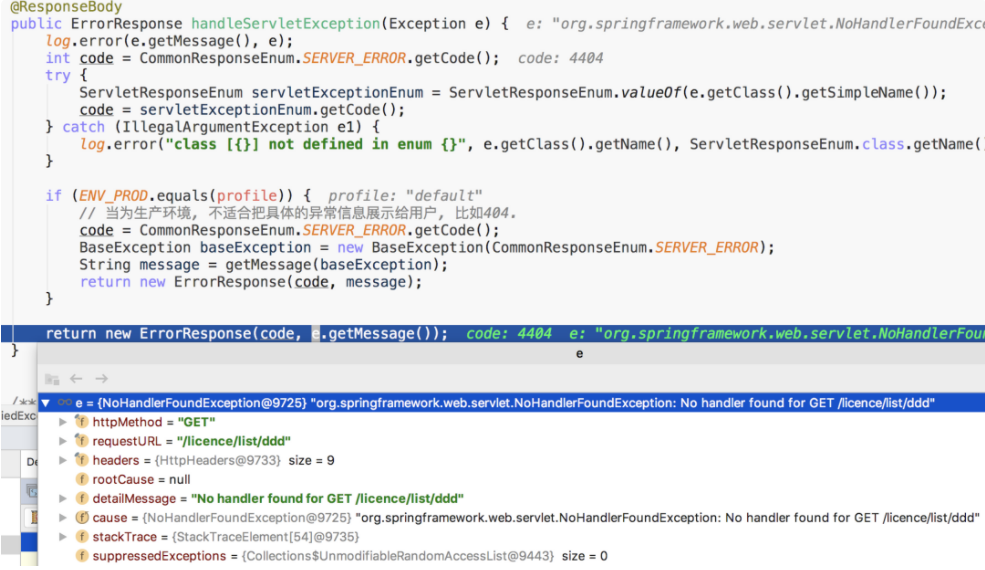 ②http 方法不支持:http://localhost:10000/licence
②http 方法不支持:http://localhost:10000/licence
PostMapping:
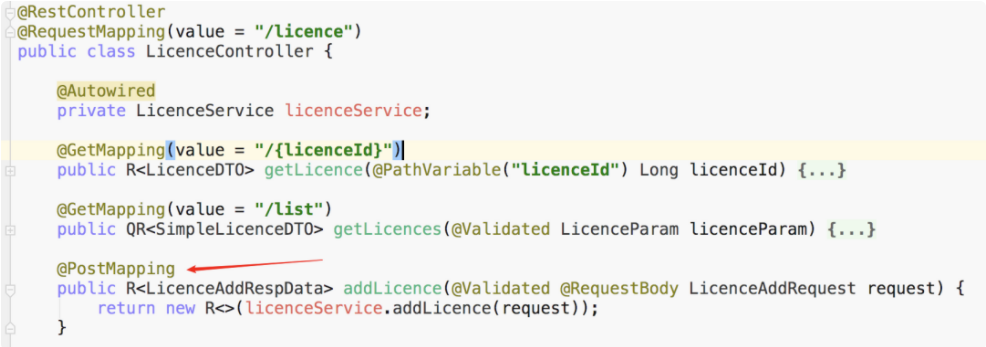
捕获 Request method not supported 异常:
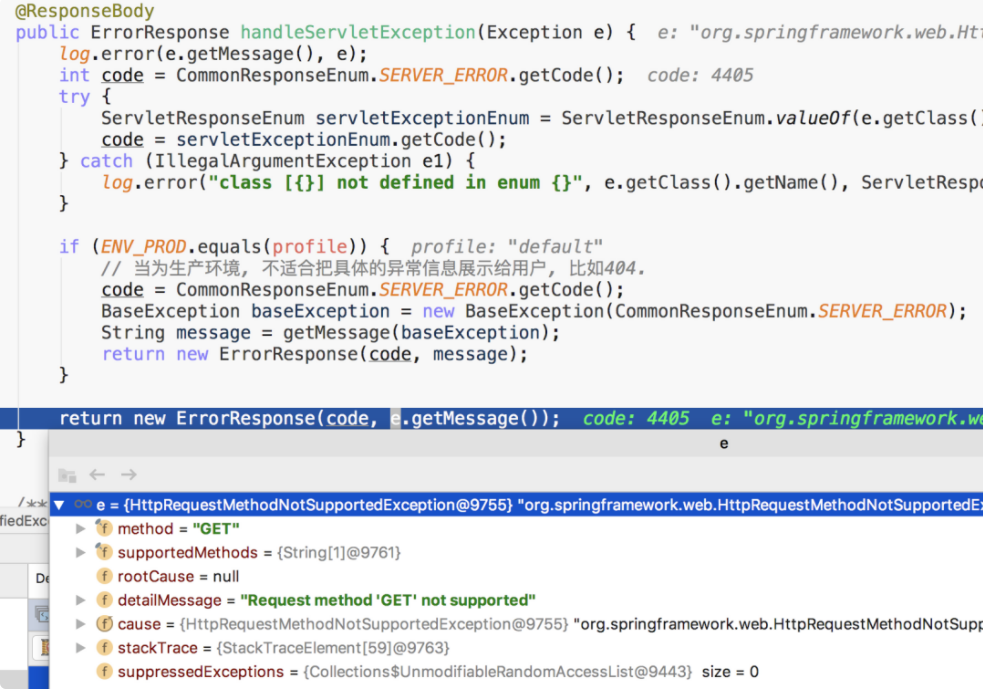
Request method not supported:
 ③校验异常 1:http://localhost:10000/licence/list?licenceType=
③校验异常 1:http://localhost:10000/licence/list?licenceType=
getLicences:

LicenceParam:

捕获参数绑定校验异常:
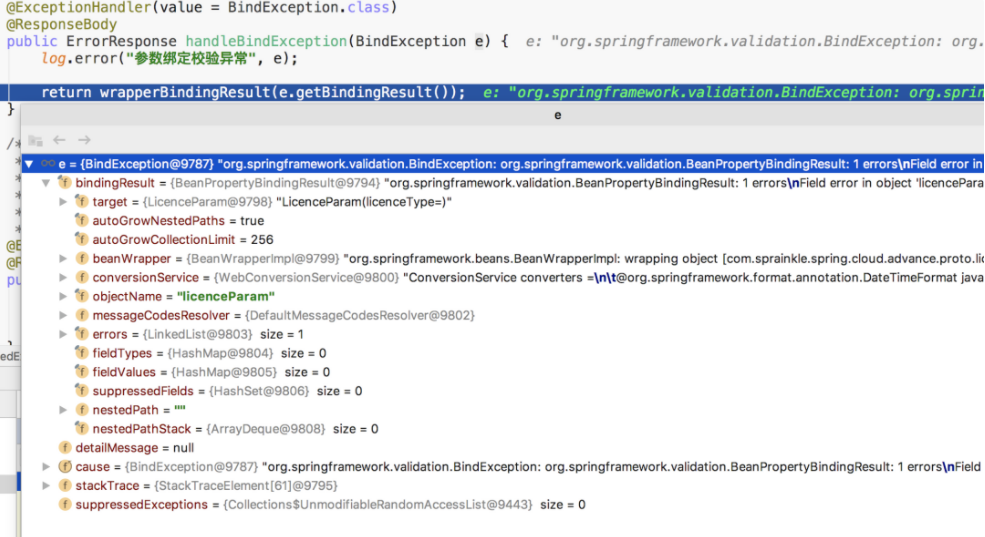 licence type cannot be empty:
licence type cannot be empty:

④校验异常 2:post 请求,这里使用 postman 模拟
addLicence:

LicenceAddRequest:
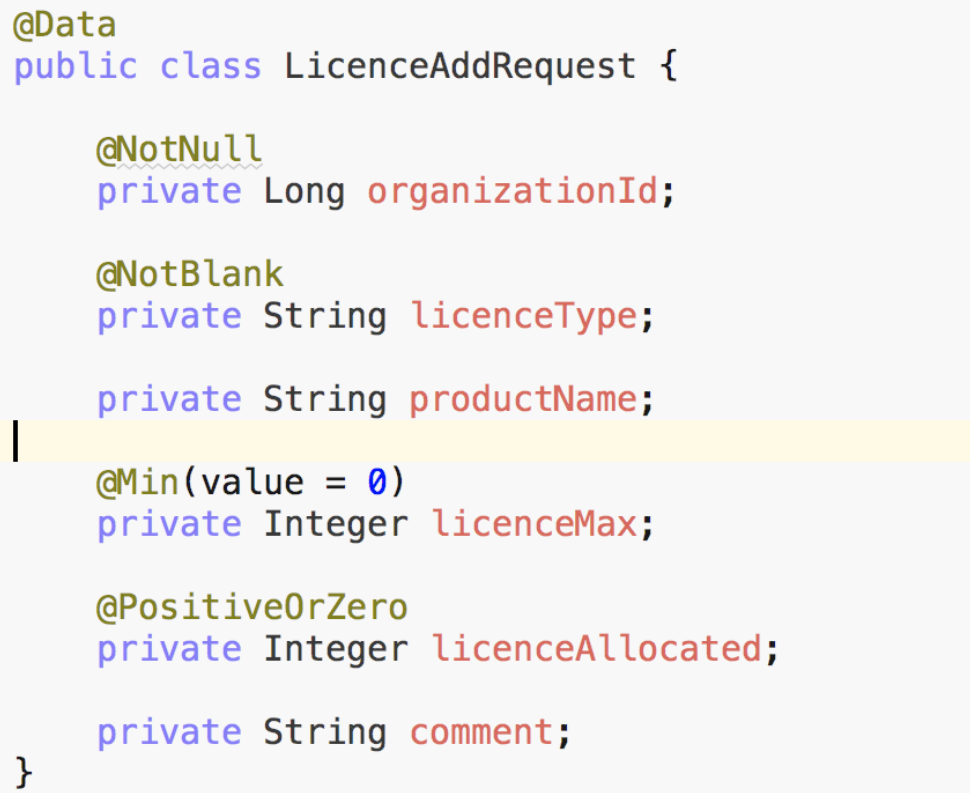
请求 url 即结果:
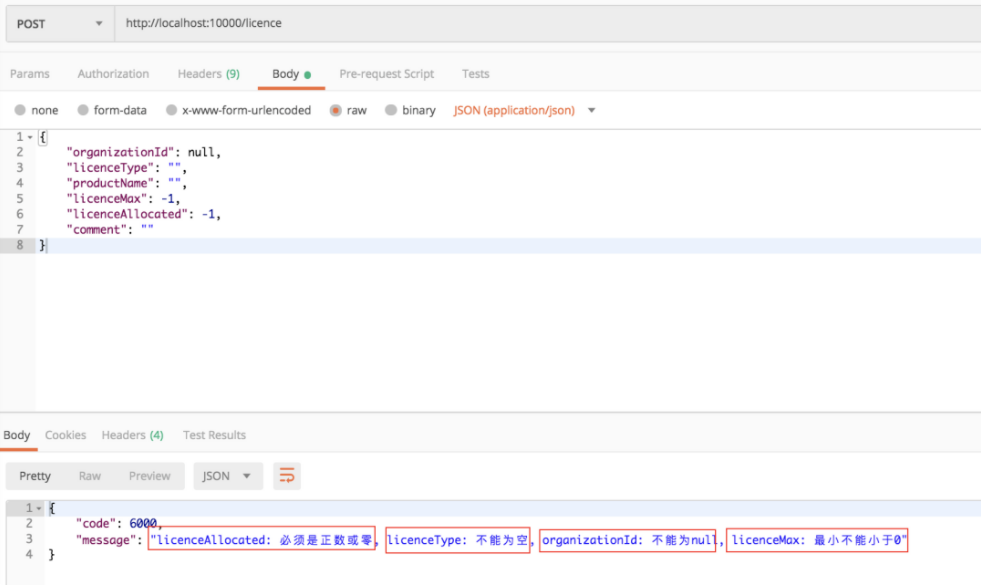
捕获参数绑定校验异常:

注:因为参数绑定校验异常的异常信息的获取方式与其它异常不一样,所以才把这 2 种情况的异常从进入 Controller 前的异常单独拆出来,下面是异常信息的收集逻辑。
异常信息的收集:

| 捕获未知异常
假设我们现在随便对 Licence 新增一个字段 test,但不修改数据库表结构,然后访问:http://localhost:10000/licence/1。
增加 test 字段:
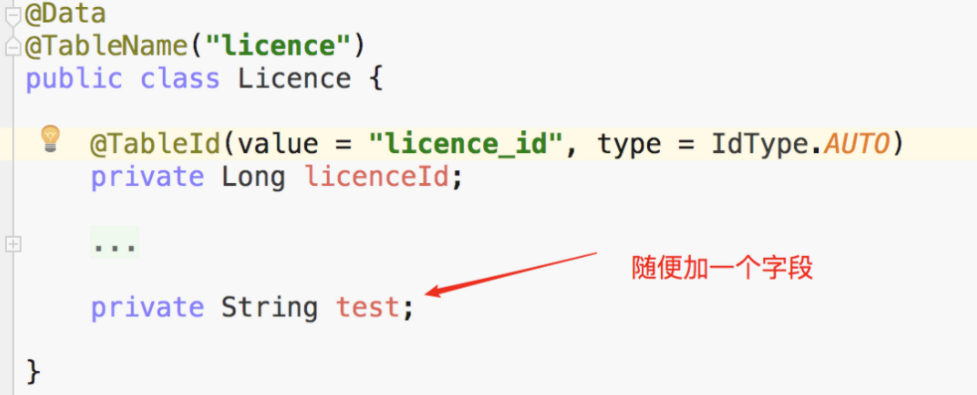
捕获数据库异常:
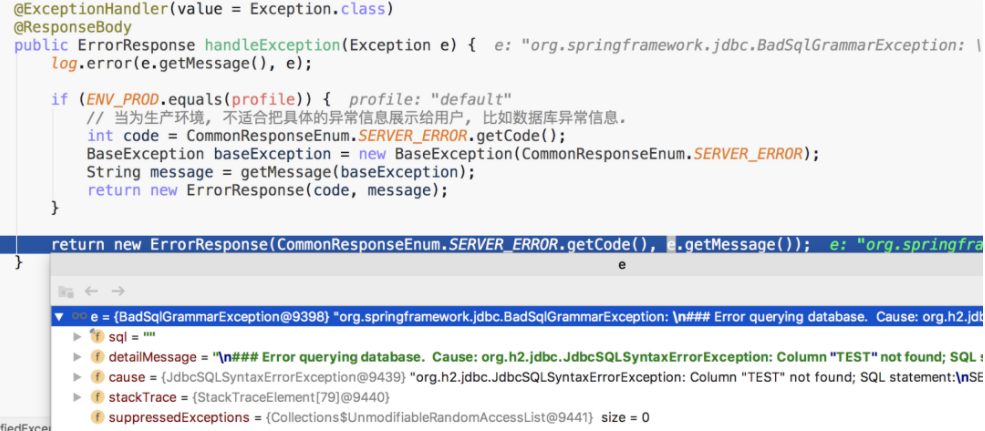
Error querying database:

小结
可以看到,测试的异常都能够被捕获,然后以 code、message 的形式返回。
每一个项目/模块,在定义业务异常的时候,只需定义一个枚举类,然后实现接口 BusinessExceptionAssert,最后为每一种业务异常定义对应的枚举实例即可,而不用定义许多异常类。使用的时候也很方便,用法类似断言。
扩展
在生产环境,若捕获到未知异常或者 ServletException,因为都是一长串的异常信息,若直接展示给用户看,显得不够专业,于是,我们可以这样做:当检测到当前环境是生产环境,那么直接返回 "网络异常"。
生产环境返回“网络异常”:
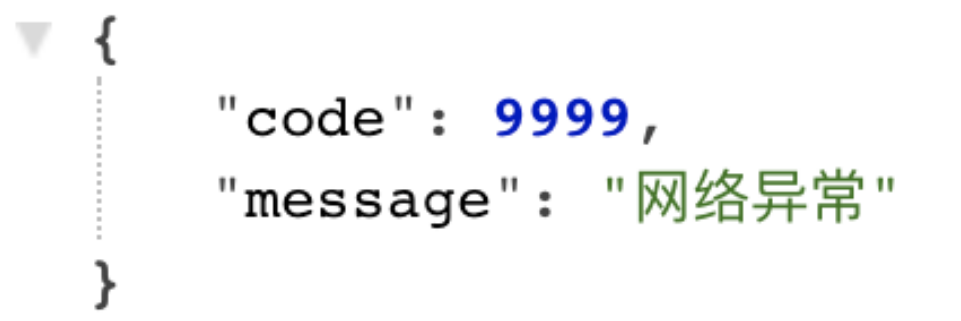
可以通过以下方式修改当前环境:
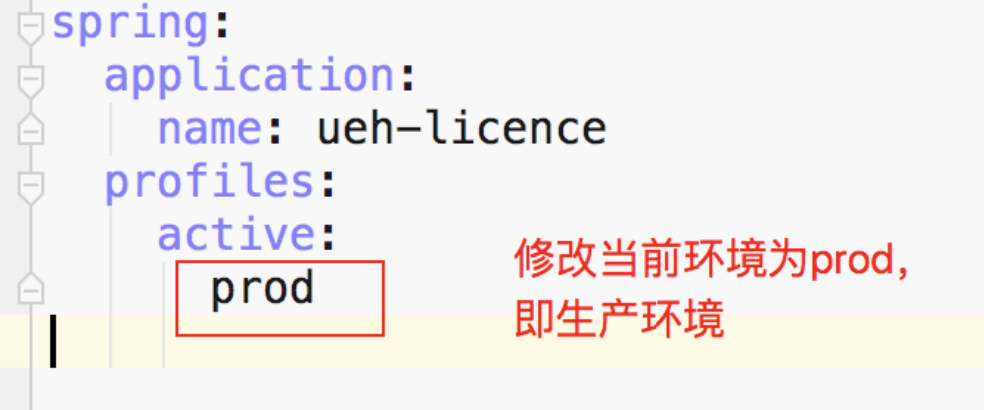
总结
使用断言和枚举类相结合的方式,再配合统一异常处理,基本大部分的异常都能够被捕获。
为什么说大部分异常,因为当引入 spring cloud security 后,还会有认证/授权异常,网关的服务降级异常、跨模块调用异常、远程调用第三方服务异常等,这些异常的捕获方式与本文介绍的不太一样,不过限于篇幅,这里不做详细说明,以后会有单独的文章介绍。
另外,当需要考虑国际化的时候,捕获异常后的异常信息一般不能直接返回,需要转换成对应的语言,不过本文已考虑到了这个,获取消息的时候已经做了国际化映射,逻辑如下:
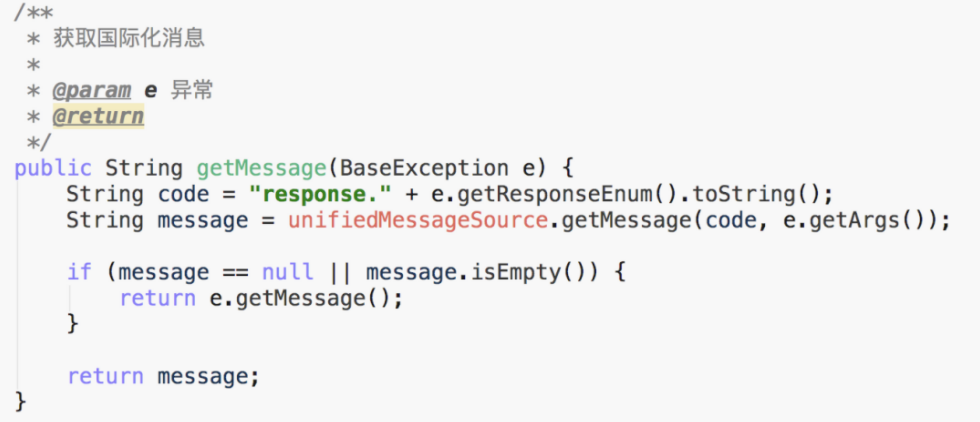 获取国际化消息
获取国际化消息
最后总结,全局异常属于老生长谈的话题,希望这次通过手机的项目对大家有点指导性的学习,大家根据实际情况自行修改。
也可以采用以下的 jsonResult 对象的方式进行处理,也贴出来代码:
@Slf4j
@RestControllerAdvice
publicclassGlobalExceptionHandler{
/**
*没有登录
*@paramrequest
*@paramresponse
*@parame
*@return
*/
@ExceptionHandler(NoLoginException.class)
publicObjectnoLoginExceptionHandler(HttpServletRequestrequest,HttpServletResponseresponse,Exceptione)
{
log.error("[GlobalExceptionHandler][noLoginExceptionHandler]exception",e);
JsonResultjsonResult=newJsonResult();
jsonResult.setCode(JsonResultCode.NO_LOGIN);
jsonResult.setMessage("用户登录失效或者登录超时,请先登录");
returnjsonResult;
}
/**
*业务异常
*@paramrequest
*@paramresponse
*@parame
*@return
*/
@ExceptionHandler(ServiceException.class)
publicObjectbusinessExceptionHandler(HttpServletRequestrequest,HttpServletResponseresponse,Exceptione)
{
log.error("[GlobalExceptionHandler][businessExceptionHandler]exception",e);
JsonResultjsonResult=newJsonResult();
jsonResult.setCode(JsonResultCode.FAILURE);
jsonResult.setMessage("业务异常,请联系管理员");
returnjsonResult;
}
/**
*全局异常处理
*@paramrequest
*@paramresponse
*@parame
*@return
*/
@ExceptionHandler(Exception.class)
publicObjectexceptionHandler(HttpServletRequestrequest,HttpServletResponseresponse,Exceptione)
{
log.error("[GlobalExceptionHandler][exceptionHandler]exception",e);
JsonResultjsonResult=newJsonResult();
jsonResult.setCode(JsonResultCode.FAILURE);
jsonResult.setMessage("系统错误,请联系管理员");
returnjsonResult;
}
-End-
审核编辑 :李倩
-
处理器
+关注
关注
68文章
19135浏览量
228931 -
控制器
+关注
关注
112文章
16151浏览量
177245 -
代码
+关注
关注
30文章
4733浏览量
68291
原文标题:为什么不建议用try catch处理异常?
文章出处:【微信号:AndroidPush,微信公众号:Android编程精选】欢迎添加关注!文章转载请注明出处。
发布评论请先 登录
相关推荐
HarmonyOS Next原生应用开发-从TS到ArkTS的适配规则(十四)
LMV321AIDBVR在板子上面不工作,出现异常不亮灯的情况,为什么?
嵌入式C编程常用的异常错误处理
一站式统一返回值封装、异常处理、异常错误码解决方案—最强的Sping Boot接口优雅响应处理器
熔纤机放电异常怎么处理
鸿蒙原生应用开发-ArkTS语言基础类库异步并发简述async/await
介绍C语言中错误处理和异常处理的一些常用的方法和策略
Service层的异常处理
输电线路常见异常及处理原则
为什么不建议用kill-9关闭程序?





 为什么不建议用try catch处理异常?
为什么不建议用try catch处理异常?

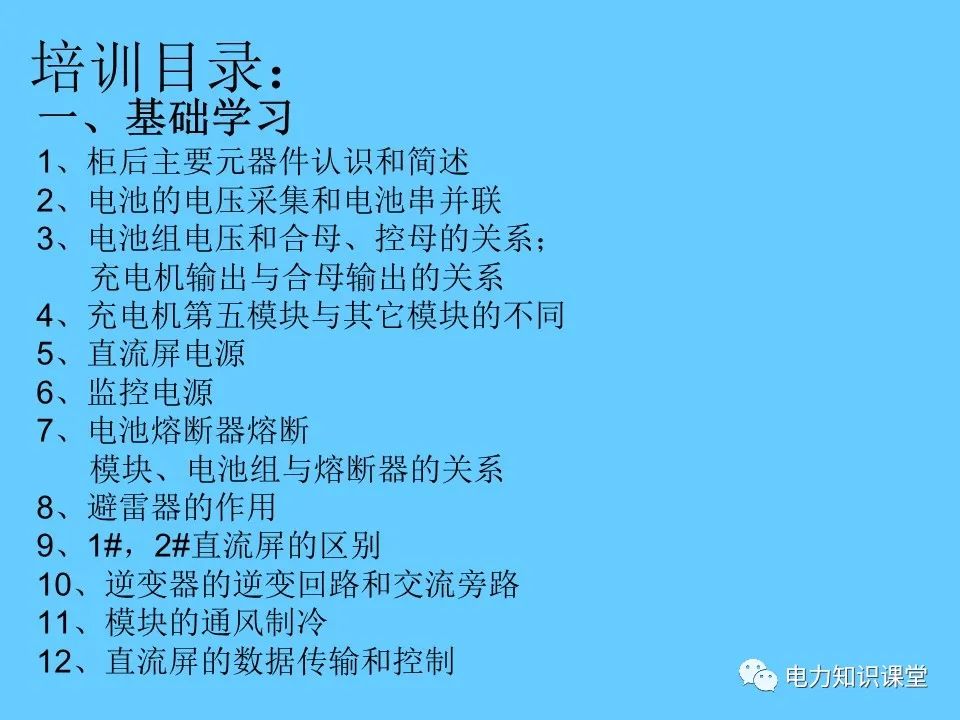











评论